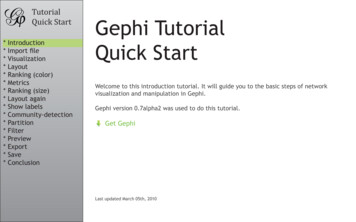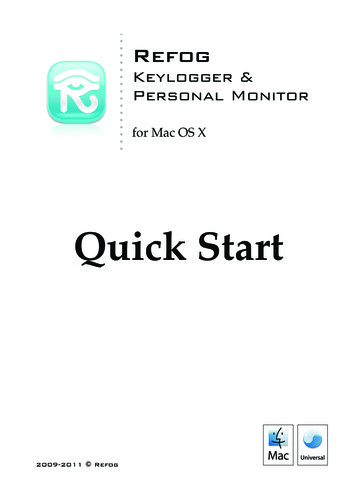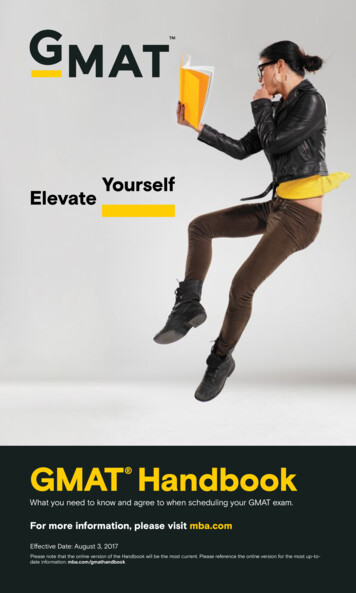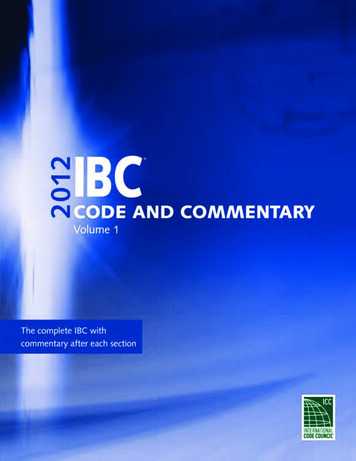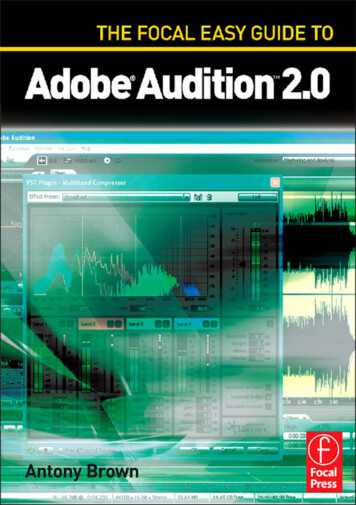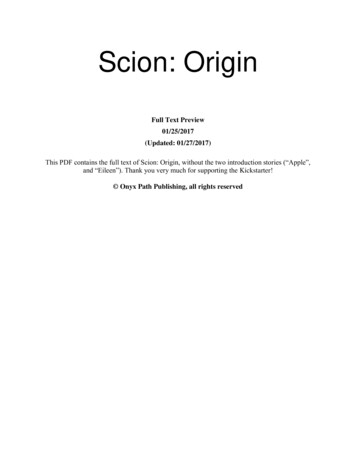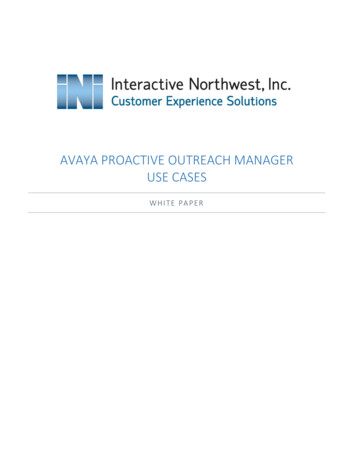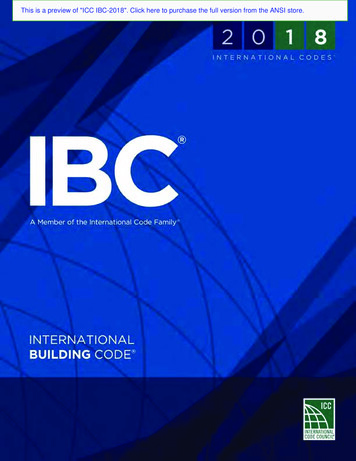
Transcription
This is a preview of "ICC IBC-2018". Click here to purchase the full version from the ANSI store.
This is a preview of "ICC IBC-2018". Click here to purchase the full version from the ANSI store.2 0 1 8INTERNATIONAL CODES2018 I-CODE BONUS OFFERIBC A Member of the International Code Family INTERNATIONALBUILDING CODE Get a free 45-day online subscriptionto ICC’s premiumACCESS 2018 I-CodesComplete Collection. Test drive manypowerful, time-saving tools available to youfrom premiumACCESS. To activate yourbonus, visit www.iccsafe.org/codebonus.
This is a preview of "ICC IBC-2018". Click here to purchase the full version from the ANSI store.2018 International Building Code First Printing: August 2017ISBN: 978-1-60983-735-8 (soft-cover edition)ISBN: 978-1-60983-734-1 (loose-leaf edition)COPYRIGHT 2017byINTERNATIONAL CODE COUNCIL, INC.Date of First Publication: August 31, 2017ALL RIGHTS RESERVED. This 2018 International Building Code is a copyrighted work owned by the International CodeCouncil, Inc. Without advance written permission from the copyright owner, no part of this book may be reproduced, distributedor transmitted in any form or by any means, including, without limitation, electronic, optical or mechanical means (by way ofexample, and not limitation, photocopying, or recording by or in an information storage retrieval system). For information onuse rights and permissions, please contact: Publications, 4051 Flossmoor Road, Country Club Hills, IL 60478. Phone 1-888ICC-SAFE (422-7233).Trademarks: “International Code Council,” the “International Code Council” logo, “ICC,” the “ICC” logo, “International Building Code,” “IBC” and other names and trademarks appearing in this book are trademarks of the International Code Council, Inc.,and/or its licensors (as applicable), and may not be used without permission.PRINTED IN THE U.S.A.
This is a preview of "ICC IBC-2018". Click here to purchase the full version from the ANSI store.PREFACEIntroductionThe International Building Code (IBC ) establishes minimum requirements for building systemsusing prescriptive and performance-related provisions. It is founded on broad-based principles thatmake possible the use of new materials and new building designs. This 2018 edition is fully compatible with all of the International Codes (I-Codes ) published by the International Code Council (ICC ), including the International Energy Conservation Code , International Existing Building Code ,International Fire Code , International Fuel Gas Code , International Green Construction Code ,International Mechanical Code , International Plumbing Code , International Private Sewage Disposal Code , International Property Maintenance Code , International Residential Code , International Swimming Pool and Spa Code , International Wildland-Urban Interface Code , InternationalZoning Code and International Code Council Performance Code .The I-Codes, including this International Building Code, are used in a variety of ways in both thepublic and private sectors. Most industry professionals are familiar with the I-Codes as the basis oflaws and regulations in communities across the U.S. and in other countries. However, the impact ofthe codes extends well beyond the regulatory arena, as they are used in a variety of nonregulatorysettings, including: Voluntary compliance programs such as those promoting sustainability, energy efficiencyand disaster resistance. The insurance industry, to estimate and manage risk, and as a tool in underwriting and ratedecisions. Certification and credentialing of individuals involved in the fields of building design, construction and safety. Certification of building and construction-related products. U.S. federal agencies, to guide construction in an array of government-owned properties. Facilities management. “Best practices” benchmarks for designers and builders, including those who are engaged inprojects in jurisdictions that do not have a formal regulatory system or a governmentalenforcement mechanism. College, university and professional school textbooks and curricula. Reference works related to building design and construction.In addition to the codes themselves, the code development process brings together building professionals on a regular basis. It provides an international forum for discussion and deliberationabout building design, construction methods, safety, performance requirements, technologicaladvances and innovative products.DevelopmentThis 2018 edition presents the code as originally issued, with changes reflected in the 2003 through2015 editions and further changes approved by the ICC Code Development Process through 2017. Anew edition such as this is promulgated every 3 years.This code is intended to establish provisions that adequately protect public health, safety andwelfare; that do not unnecessarily increase construction costs; that do not restrict the use of newmaterials, products or methods of construction; and that do not give preferential treatment to particular types or classes of materials, products or methods of construction.2018 INTERNATIONAL BUILDING CODE iii
This is a preview of "ICC IBC-2018". Click here to purchase the full version from the ANSI store.MaintenanceThe International Building Code is kept up to date through the review of proposed changes submitted by code enforcement officials, industry representatives, design professionals and other interested parties. Proposed changes are carefully considered through an open code developmentprocess in which all interested and affected parties may participate.The ICC Code Development Process reflects principles of openness, transparency, balance, dueprocess and consensus, the principles embodied in OMB Circular A-119, which governs the federalgovernment’s use of private-sector standards. The ICC process is open to anyone; there is no cost toparticipate, and people can participate without travel cost through the ICC’s cloud-based app, cdpAccess . A broad cross section of interests are represented in the ICC Code Development Process.The codes, which are updated regularly, include safeguards that allow for emergency action whenrequired for health and safety reasons.In order to ensure that organizations with a direct and material interest in the codes have a voicein the process, the ICC has developed partnerships with key industry segments that support theICC’s important public safety mission. Some code development committee members were nominated by the following industry partners and approved by the ICC Board: American Institute of Architects (AIA) National Association of Home Builders (NAHB) National Association of State Fire Marshals (NASFM)The code development committees evaluate and make recommendations regarding proposedchanges to the codes. Their recommendations are then subject to public comment and council-widevotes. The ICC’s governmental members—public safety officials who have no financial or businessinterest in the outcome—cast the final votes on proposed changes.The contents of this work are subject to change through the code development cycles and by anygovernmental entity that enacts the code into law. For more information regarding the code development process, contact the Codes and Standards Development Department of the InternationalCode Council.While the I-Code development procedure is thorough and comprehensive, the ICC, its membersand those participating in the development of the codes disclaim any liability resulting from thepublication or use of the I-Codes, or from compliance or noncompliance with their provisions. TheICC does not have the power or authority to police or enforce compliance with the contents of thiscode.Code Development Committee Responsibilities(Letter Designations in Front of Section Numbers)In each code development cycle, code change proposals to this code are considered at the Committee Action Hearings by 11 different code development committees. Four of these committees haveprimary responsibility for designated chapters and appendices as follows:IBC—EgressCode Development Committee [BE]: Chapters 10, 11, Appendix EIBC—Fire SafetyCode Development Committee [BF]: Chapters 7, 8, 9, 14, 26IBC—GeneralCode Development Committee [BG]: Chapters 2, 3, 4, 5, 6, 12, 27, 28, 29, 30, 31, 32, 33,Appendices A, B, C, D, K, NIBC—StructuralCode Development Committee [BS]: Chapters 15, 16, 17, 18, 19, 20, 21, 22, 23, 24, 25,Appendices F, G, H, I, J, L, Miv2018 INTERNATIONAL BUILDING CODE
This is a preview of "ICC IBC-2018". Click here to purchase the full version from the ANSI store.Code change proposals to sections of the code that are preceded by a bracketed letter designation, such as [A], will be considered by a committee other than the building code committee listedfor the chapter or appendix on the preceding page. For example, proposed code changes to Section[F] 307.1.1 will be considered by the International Fire Code Development Committee during theCommittee Action Hearing in the 2018 (Group A) code development cycle.Another example is Section [BF] 1505.2. While code change proposals to Chapter 15 are primarily the responsibility of the IBC—Structural Code Development Committee, which considers codechange proposals during the 2019 (Group B) code development cycle, Section 1505.2 is the responsibility of the IBC—Fire Safety Code Development Committee, which considers code change proposals during the 2018 (Group A) code development cycle.The bracketed letter designations for committees responsible for portions of this code are as follows:[A] Administrative Code Development Committee;[BE] IBC—Egress Code Development Committee;[BF] IBC—Fire Safety Code Development Committee;[BG] IBC—General Code Development Committee;[BS] IBC—Structural Code Development Committee;[E] International Commercial Energy Conservation Code Development Committee orInternational Residential Energy Conservation Code Development Committee;[EB] International Existing Building Code Development Committee;[F] International Fire Code Development Committee;[FG] International Fuel Gas Code Development Committee;[M] International Mechanical Code Development Committee; and[P] International Plumbing Code Development Committee.For the development of the 2021 edition of the I-Codes, there will be two groups of code development committees and they will meet in separate years.2018 INTERNATIONAL BUILDING CODE v
This is a preview of "ICC IBC-2018". Click here to purchase the full version from the ANSI store.Group A Codes(Heard in 2018, Code Change ProposalsDeadline: January 8, 2018)International Building Code– Egress (Chapters 10, 11, Appendix E)– Fire Safety (Chapters 7, 8, 9, 14, 26)– General (Chapters 2–6, 12, 27–33,Appendices A, B, C, D, K, N)International Fire CodeInternational Fuel Gas CodeInternational Mechanical CodeInternational Plumbing CodeInternational Property Maintenance CodeInternational Private Sewage Disposal CodeGroup B Codes(Heard in 2019, Code Change ProposalsDeadline: January 7, 2019)Administrative Provisions (Chapter 1 of allcodes except IECC, IRC and IgCC, administrative updates to currently referenced standards, and designated definitions)International Building Code– Structural (Chapters 15–25, Appendices F,G, H, I, J, L, M)International Existing Building CodeInternational Energy Conservation Code—CommercialInternational Energy Conservation Code—Residential– IECC—Residential– IRC—Energy (Chapter 11)International Green Construction Code(Chapter 1)International Residential Code– IRC—Building (Chapters 1–10,Appendices E, F, H, J, K, L, M, O, Q, R, S, T)International Residential Code– IRC—Mechanical (Chapters 12–23)– IRC—Plumbing (Chapters 25–33,Appendices G, I, N, P)International Swimming Pool and Spa CodeInternational Wildland-Urban Interface CodeInternational Zoning CodeNote: Proposed changes to the ICC Performance Code will be heard by the code development committee noted in brackets [ ] in the text of the ICC Performance Code .Code change proposals submitted for code sections that have a letter designation in front ofthem will be heard by the respective committee responsible for such code sections. Because different committees hold Committee Action Hearings in different years, proposals for the IBC will beheard by committees in both the 2018 (Group A) and the 2019 (Group B) code development cycles.For instance, every section of Chapter 16 is the responsibility of the IBC—Structural Code Development Committee. As noted in the preceding table, that committee will hold its Committee ActionHearings in 2019 to consider code change proposals for the chapters for which it is responsible.Therefore any proposals received for Chapter 16 of this code will be assigned to the IBC—StructuralCode Development Committee and will be considered in 2019, during the Group B code changecycle.As another example, every section of Chapter 1 of this code is designated as the responsibility ofthe Administrative Code Development Committee, which is part of the Group B portion of the hearings. This committee will hold its Committee Action Hearings in 2019 to consider code change proposals for Chapter 1 of all I-Codes except the International Energy Conservation Code, InternationalResidential Code and International Green Construction Code. Therefore, any proposals received forChapter 1 of this code will be assigned to the Administrative Code Development Committee for consideration in 2019.It is very important that anyone submitting code change proposals understands which codedevelopment committee is responsible for the section of the code that is the subject of the codechange proposal. For further information on the Code Development Committee responsibilities,please visit the ICC website at www.iccsafe.org/scoping.vi2018 INTERNATIONAL BUILDING CODE
This is a preview of "ICC IBC-2018". Click here to purchase the full version from the ANSI store.Marginal MarkingsSolid vertical lines in the margins within the body of the code indicate a technical change from therequirements of the 2015 edition. Deletion indicators in the form of an arrow ( ) are provided inthe margin where an entire section, paragraph, exception or table has been deleted or an item in alist of items or a table has been deleted.A single asterisk [*] placed in the margin indicates that text or a table has been relocated withinthe code. A double asterisk [**] placed in the margin indicates that the text or table immediatelyfollowing it has been relocated there from elsewhere in the code. The following table indicates suchrelocations in the 2018 edition of the International Building Code.2018 LOCATION2015 ation of the International CodesThe coordination of technical provisions is one of the strengths of the ICC family of model codes.The codes can be used as a complete set of complementary documents, which will provide userswith full integration and coordination of technical provisions. Individual codes can also be used insubsets or as stand-alone documents. To make sure that each individual code is as complete as possible, some technical provisions that are relevant to more than one subject area are duplicated insome of the model codes. This allows users maximum flexibility in their application of the I-Codes.Italicized TermsSelected words and terms defined in Chapter 2, Definitions, are italicized where they appear in codetext and the Chapter 2 definition applies. Where such words and terms are not italicized, commonuse definitions apply. The words and terms selected have code-specific definitions that the usershould read carefully to facilitate better understanding of the code. Note: In Sections 1903 through1905, italics indicate provisions that differ from ACI 318.2018 INTERNATIONAL BUILDING CODE vii
This is a preview of "ICC IBC-2018". Click here to purchase the full version from the ANSI store.AdoptionThe International Code Council maintains a copyright in all of its codes and standards. Maintainingcopyright allows the ICC to fund its mission through sales of books, in both print and electronic formats. The ICC welcomes adoption of its codes by jurisdictions that recognize and acknowledge theICC’s copyright in the code, and further acknowledge the substantial shared value of the public/private partnership for code development between jurisdictions and the ICC.The ICC also recognizes the need for jurisdictions to make laws available to the public. AllI-Codes and I-Standards, along with the laws of many jurisdictions, are available for free in anondownloadable form on the ICC’s website. Jurisdictions should contact the ICC at adoptions@iccsafe.org to learn how to adopt and distribute laws based on the International Building Code in a manner that provides necessary access, while maintaining the ICC’s copyright.To facilitate adoption, several sections of this code contain blanks for fill-in informationthat needs to be supplied by the adopting jurisdiction as part of the adoption legislation. Forthis code, please see:Section 101.1. Insert: [NAME OF JURISDICTION]Section 1612.3. Insert: [NAME OF JURISDICTION]Section 1612.3. Insert: [DATE OF ISSUANCE]viii2018 INTERNATIONAL BUILDING CODE
This is a preview of "ICC IBC-2018". Click here to purchase the full version from the ANSI store.EFFECTIVE USE OF THE INTERNATIONAL BUILDING CODEThe International Building Code (IBC ) is a model code that provides minimum requirements tosafeguard the public health, safety and general welfare of the occupants of new and existing buildings and structures. The IBC is fully compatible with the ICC family of codes, including: InternationalEnergy Conservation Code (IECC ), International Existing Building Code (IEBC ), International FireCode (IFC ), International Fuel Gas Code (IFGC ), International Green Construction Code (IgCC ),International Mechanical Code (IMC ), International Plumbing Code (IPC ), International PrivateSewage Disposal Code (IPSDC ), International Property Maintenance Code (IPMC ), InternationalResidential Code (IRC ), International Swimming Pool and Spa Code (ISPSC ), International Wildland-Urban Interface Code (IWUIC ), International Zoning Code (IZC ) and International CodeCouncil Performance Code (ICCPC ).The IBC addresses structural strength, means of egress, sanitation, adequate lighting and ventilation, accessibility, energy conservation and life safety in regard to new and existing buildings, facilities and systems. The codes are promulgated on a 3-year cycle to allow for new constructionmethods and technologies to be incorporated into the codes. Alternative materials, designs andmethods not specifically addressed in the code can be approved by the building official where theproposed materials, designs or methods comply with the intent of the provisions of the code (seeSection 104.11).The IBC applies to all occupancies, including one- and two-family dwellings and townhouses thatare not within the scope of the IRC. The IRC is referenced for coverage of detached one- and twofamily dwellings and townhouses as defined in the exception to Section 101.2 and the definition for“Townhouse” in Chapter 2. The IRC can also be used for the construction of live/work units (asdefined in Section 419) and small bed and breakfast-style hotels where there are five or fewer guestrooms and the hotel is owner occupied. The IBC applies to all types of buildings and structuresunless exempted. Work exempted from permits is listed in Section 105.2.Arrangement and Format of the 2018 IBCBefore applying the requirements of the IBC, it is beneficial to understand its arrangement and format. The IBC, like other codes published by ICC, is arranged and organized to follow sequential stepsthat generally occur during a plan review or inspection.Chapters1-23SubjectsAdministration and definitionsUse and occupancy classifications4, 31Special requirements for specific occupancies or elements5-6Height and area limitations based on type of construction7-9Fire resistance and protection requirements10Requirements for evacuation11Specific requirements to allow use and access to a building for persons withdisabilities12-13, 27-3014-26Building systems, such as lighting, HVAC, plumbing fixtures, elevatorsStructural components—performance and stability32Encroachment outside of property lines33Safeguards during construction35Referenced standardsAppendices A-M Appendices2018 INTERNATIONAL BUILDING CODE ix
This is a preview of "ICC IBC-2018". Click here to purchase the full version from the ANSI store.The IBC requirements for hazardous materials, fire-resistance-rated construction, interior finish,fire protection systems, means of egress, emergency and standby power, and temporary structuresare directly correlated with the requirements of the IFC. The following chapters/sections of the IBCare correlated to the tions 307, 414, 415Chapters 50-67Hazardous materials and Group H requirementsChapter 7Chapter 7Fire-resistance-rated construction (Fire andsmoke protection features in the IFC)Chapter 8Chapter 8Interior finish, decorative materials andfurnishingsChapter 9Chapter 9Fire protection systemsChapter 10Chapter 10Means of egressChapter 27Section 604Standby and emergency powerSection 3103Chapter 31Temporary structuresThe IBC requirements for smoke control systems, and smoke and fire dampers are directly correlated to the requirements of the IMC. IBC Chapter 28 is a reference to the IMC and the IFGC forchimneys, fireplaces and barbecues, and all aspects of mechanical systems. The following chapters/sections of the IBC are correlated with the tion 717Section 607Smoke and fire dampersSection 909Section 513Smoke controlThe IBC requirements for plumbing fixtures and toilet rooms are directly correlated to therequirements of the IPC. The following chapters/sections of the IBC are correlated with the IPC:IBCChapter/SectionIPCChapter/SectionChapter 29Chapters 3 & 4SubjectPlumbing fixtures and facilitiesThe following is a chapter-by-chapter synopsis of the scope and intent of the provisions of theInternational Building Code.Chapter 1 Scope and Administration. Chapter 1 establishes the limits of applicability of thecode and describes how the code is to be applied and enforced. Chapter 1 is in two parts, Part 1—Scope and Application (Sections 101-102) and Part 2—Administration and Enforcement (Sections103-116). Section 101 identifies which buildings and structures come under its purview and references other I-Codes as applicable. Standards and codes are scoped to the extent referenced (seeSection 102.4).The building code is intended to be adopted as a legally enforceable document and it cannot beeffective without adequate provisions for its administration and enforcement. The provisions ofChapter 1 establish the authority and duties of the building official appointed by the authority having jurisdiction and also establish the rights and privileges of the design professional, contractor andproperty owner.Chapter 2 Definitions. An alphabetical listing of all defined terms is located in Chapter 2. Definedterms that are pertinent to a specific chapter or section are also found in that chapter or sectionwith a reference back to Chapter 2 for the definition. While a defined term may be listed in onechapter or another, the meaning is applicable throughout the code.Codes are technical documents and every word, term and punctuation mark can impact themeaning of the code text and the intended results. The code often uses terms that have a uniquex2018 INTERNATIONAL BUILDING CODE
This is a preview of "ICC IBC-2018". Click here to purchase the full version from the ANSI store.meaning in the code and the code meaning can differ substantially from the ordinarily understoodmeaning of the term as used outside of the code. Where understanding of a term’s definition isespecially key to or necessary for understanding a particular code provision, the term is shown initalics wherever it appears in the code.The user of the code should be familiar with and consult this chapter because the definitions areessential to the correct interpretation of the code. Where a term is not defined, such terms shallhave the ordinarily accepted meaning.Chapter 3 Use and Occupancy Classification. Chapter 3 provides for the classification ofbuildings, structures and parts thereof based on the purpose or purposes for which they are used.Section 302 identifies the groups into which all buildings, structures and parts thereof must be classified. Sections 303 through 312 identify the occupancy characteristics of each group classification.In some sections, specific group classifications having requirements in common are collectivelyorganized such that one term applies to all. For example, Groups A-1, A-2, A-3, A-4 and A-5 are individual groups for assembly-type buildings. The general term “Group A,” however, includes each ofthese individual groups. Other groups include Business (B), Educational (E), Factory (F-1, F-2), HighHazard (H-1, H-2, H-3, H-4, H-5), Institutional (I-1, I-2, I-3, I-4), Mercantile (M), Residential (R-1, R-2,R-3, R-4), Storage (S-1, S-2) and Utility (U). In some occupancies, the smaller number means a higherhazard, but that is not always the case.Defining the use of the buildings is very important as it sets the tone for the remaining chaptersof the code. Occupancy works with the height, area and construction type requirements in Chapters5 and 6, as well as the special provisions in Chapter 4, to determine “equivalent risk,” or providing areasonable level of protection or life safety for building occupants. The determination of equivalentrisk involves three interdependent considerations: (1) the level of fire hazard associated with thespecific occupancy of the facility; (2) the reduction of fire hazard by limiting the floor area and theheight of the building based on the fuel load (combustible contents and burnable building components); and (3) the level of overall fire resistance provided by the type of construction used for thebuilding. The greater the potential fire hazards indicated as a function of the group, the lesser theheight and area allowances for a particular construction type.Occupancy classification also plays a key part in organizing and prescribing the appropriate protection measures. As such, threshold requirements for fire protection and means of egress systemsare based on occupancy classification (see Chapters 9 and 10). Other sections of the code also contain requirements respective to the classification of building groups. For example, Section 706 specifies requirements for fire wall fire-resistance ratings that are tied to the occupancy classification ofa building and Section 803.11 contains interior finish requirements that are dependent upon theoccupancy classification. The use of the space, rather than the occupancy of the building, is utilizedfor determining occupant loading (Section 1004) and live loading (Section 1607).Over the useful life of a building, the activities in the building will evolve and change. Where theprovisions of the code address uses differently, moving from one activity to another or from onelevel of activity to another is, by definition, a change of occupancy. The new occupancy must be incompliance with the applicable provisions.Chapter 4 Special Detailed Requirements Based on Use and Occupancy. Chapter 4 contains the requirements for protecting special uses and occupancies, which are supplemental to theremainder of the code. Chapter 4 contains provisions that may alter requirements found elsewherein the code; however, the general requirements of the code still apply unless modified within thechapter. For example, the height and area limitations established in Chapter 5 apply to all specialoccupancies unless Chapter 4 contains height and area limitations. In this case, the limitations inChapter 4 supersede those in other sections. An example of this is the height and area limitationsfor open parking garages given in Section 406.5.4, which supersede the limitations given in Sections504 and 506.In some instances, it may not be necessary to apply the provisions of Chapter 4. For example, if acovered mall building complies with the provisions of the code for Group M, Section 402 does notapply; however, other sections that address a use, process or operation must be applied to that specific occupancy, such as stages and platforms, special amusement buildings and hazardous materials(Sections 410, 411 and 414).The chapter includes requirements for buildings and conditions that apply to one or moregroups, such as high-rise buildings, underground buildings or atriums. Special uses may also implyspecific occupancies and operations, such as for Group H, hazardous materials, application of flam2018 INTERNATIONAL BUILDING CODE xi
This is a preview of "ICC IBC-2018". Click here to purchase the full version from the ANSI store.mable finishes, drying rooms, organic coatings and combustible storage or hydrogen fuel gas rooms,all of which are coordinated with the IFC. Unique consideration is taken for special use areas, suchas covered mall buildings, motor-vehicle-related occupancies, special amusement buildings and aircraft-related occupancies. Special facilities within other occupancies are considered, such as stagesand platforms, motion picture projection rooms, children’s play structures and storm shelters.Finally, in order that the overall package of protection features can be easily understood, uniqueconsider
The International Building Code . 2015 editions and further changes approved by the ICC Code Development Process through 2017. A new edition such as this is promulgated every 3 years. This code is intended to establish provisions that adequately protect public health, safety and
